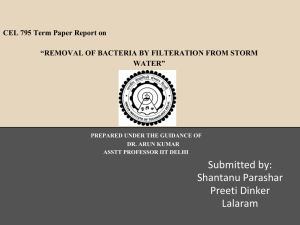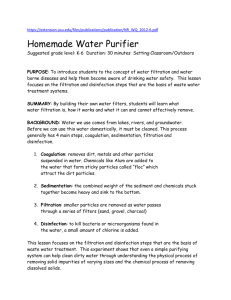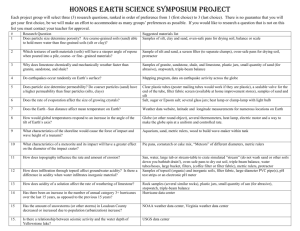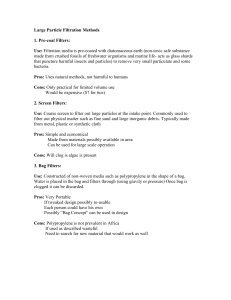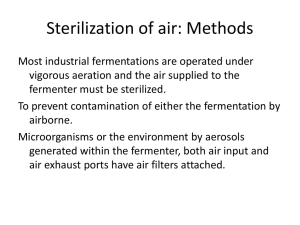Rapid Sand Filtration
advertisement
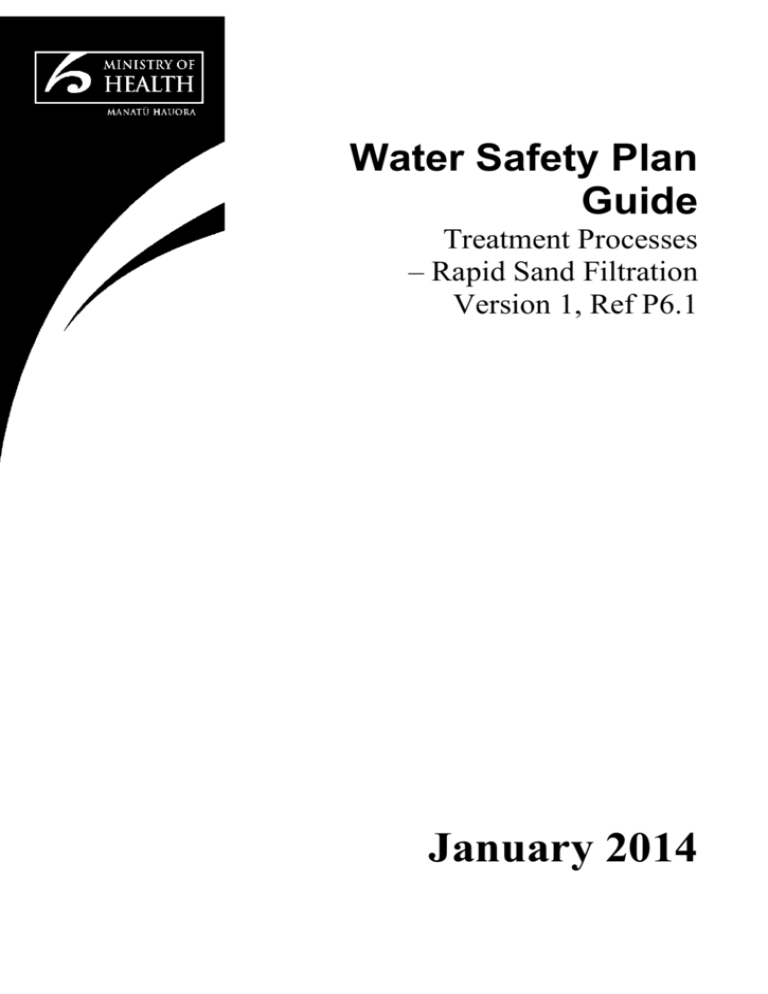
Water Safety Plan Guide Treatment Processes – Rapid Sand Filtration Version 1, Ref P6.1 January 2014 Citation: Ministry of Health. 2014. Water Safety Plan Guide: Treatment Processes – Rapid Sand Filtration, Version 1, ref p6.1. Wellington: Ministry of Health Published in January 2014 by the Ministry of Health PO Box 5013, Wellington, New Zealand ISBN: 978-0-478-42730-1 (print) ISBN: 978-0-478-42731-8 (online) Previously published in 2001 as Public Health Risk Management Plan Guide: Treatment Processes – Rapid Sand Filtration, Version 1, ref p6.1. This publication’s title and any reference within the text to ‘public health risk management plan’ were changed in January 2014 to reflect the December 2013 legislation change of the term ‘public health risk management plan’ to ‘water safety plan’. No other changes have been made to this document. This document is available on the Ministry of Health’s website: http://www.health.govt.nz This work is licensed under the Creative Commons Attribution 4.0 International licence. In essence, you are free to: share ie, copy and redistribute the material in any medium or format; adapt ie, remix, transform and build upon the material. You must give appropriate credit, provide a link to the licence and indicate if changes were made. Contents Introduction 1 Risk Summary 3 Risk Information Table 4 Contingency Plans 7 Water Safety Plan Performance Assessment 8 Ref P6.1 Version 1, January 2014 Water Safety Plan Guide: Treatment Processes – Rapid Sand Filtration iii Introduction Sand filtration is used to remove particles from drinking-water. These particles include: silts and clays flocs from the coagulation/flocculation process, or insoluble substances formed from other treatment processes larger germs such as Giardia and Cryptosporidium particles of organic matter, or with organic matter attached to them. This Guide is concerned with all sand filter types except slow sand filters. (For information on slow sand filters, see Guide P6.2.) If an event occurs during the filtration process (ie, it does not work properly), the following could happen: If particles are not removed, sickness can come from larger germs not being removed If natural organic matter is not removed, it reacts with the disinfectant and can cause sickness from germs not being killed, and from disinfection by-products If chemicals used in the coagulation/flocculation process are carried into the distribution system, they could cause sickness. The operation of filters can present risks to the health of treatment plant staff. These are acknowledged, but are not discussed further as such risks are the subject of health and safety in employment legislation. Sand filters can be used in any of three ways: In direct filtration, in which coagulant or other chemicals are dosed before the filter: – coagulant addition with low turbidity raw water (see Guide P5.3) – oxidant addition to remove iron and manganese (see Guide P8.2) – activated carbon addition to remove very low concentrations of organic substances (see Guide P8.4) As a polishing filter, after conventional coagulation/flocculation/sedimentation or dissolved air filtration (see Guides 5.1 and 5.2) As a roughing filter to remove coarser particles before final filtration using a different filter type (see other Guides in the P6 series). Several factors influence how effective a rapid sand filter is: source water quality; poor quality water or water of variable quality makes it more difficult for a filter to produce good quality water (see Guide S1.1 and Guides in the P1 series) how well treatment steps before the filter are working; if more particles can be removed before the filter, production of a good quality water is easier (see Guides in the P1, P3, P4, and P5 series) Ref P6.1 Version 1, January 2014 Water Safety Plan Guide: Treatment Processes – Rapid Sand Filtration 1 the type and depth of the filter media; removal of particles is improved by the use of more than one type of filter material and by greater depths of these materials the use of chemicals to coat the sand grains with substances that improve the attachment of particles to them design of the filter so that it matches the raw water quality and the operational requirements of the treatment plant the rate at which water passes through the filter; slower rates will give better removal of particles, sudden increases in rate will shake loose particles that are have already been trapped in the sand, causing “spikes” in the turbidity the way the filter is operated; how often the filter is backwashed, how the filter is restarted, the management of the filter ripening and the procedures used in cleaning the filter sand, for example. Filtration is the last treatment stage that can physically remove contaminants before disinfection. The effectiveness of this stage is therefore very important, because particles in the water hinder germs being killed by the disinfectant, and because the large germs (eg, Cryptosporidium) that cannot be killed by chlorine have to be physically removed. 2 Water Safety Plan Guide: Treatment Processes – Rapid Sand Filtration Ref P6.1 Version 1, January 2014 Risk Summary The event creating the greatest risk with rapid sand filtration is the poor removal of particles (see P6.1.1). The most important preventive measure is to make sure the depth and type of sand and the flow rate are suitable for the quality of water being filtered (see P6.1.1.1). (References in parentheses are to the Risk Information Table.) Ref P6.1 Version 1, January 2014 Water Safety Plan Guide: Treatment Processes – Rapid Sand Filtration 3 Risk Information Table Reliable information about water quality is essential for the proper management of a water supply. Knowledgeable and skilled staff are also essential for minimising the public health risks associated with water supplies. Please read the staff training (Guide G1) and the monitoring guides (Guide G2). While we haven’t pointed out every detail of how these documents are linked with the present document, the links are many and are important. Abbreviations: NTU – nephelometric turbidity units; DWSNZ – Drinking-Water Standards for New Zealand Causes Preventive measures Checking preventive measures Corrective action Signs that action is needed What to check Event: PARTICLES NOT REMOVED Possible hazards: Germs not removed (particularly Giardia and Cryptosporidium). Level of risk: High1 P6.1.1.1 Media deficiencies. P6.1.1.2 Inappropriate flow rates. 1 4 Ensure depth and type of medium are suitable for the quality of the water being filtered and flow rate. Determine and document acceptable flow rates, and check regularly. Include summer versus winter flows and ensure both can be matched to media specifications. Avoid sudden changes in flow rates in dirty filters. Ensure operators are trained in correct operational procedures for the specific filters in use. Visual inspection of filter. Post-filter: – – Turbidity Aluminium residual concentration. Post-filter: – – Turbidity more than 0.5 NTU after the filter. Change type, number and/or depth of filter media. Aluminium residual more than 0.15 mg/L after filter. Frequent elevated turbidity in filtered water. Turbidity more than 0.5 NTU after the filter. Restrict maximum flow rate. Aluminium residual more than 0.15 mg/L after filter. Redesign filter hydraulics. Frequent elevated turbidity in filtered water. Modify operational practices. Identify staff training needs and provide training. Turbidity Aluminium residual concentration. The consequences of the event, and therefore the level of risk, will also be largely influenced by the quality of the source water and the effectiveness of pre filter treatment processes. Water Safety Plan Guide: Treatment Processes – Rapid Sand Filtration Ref P6.1 Version 1, January 2014 Causes Preventive measures Checking preventive measures Corrective action Signs that action is needed What to check Event: PARTICLES NOT REMOVED cont’d P6.1.1.3 Incorrect filter backwash procedure. Determine which parameter(s) will be used to start the backwash cycle, and implement these controls. – – – Time Turbidity Post-filter: – – – Aluminium residual concentration Turbidity more than 0.2 NTU after the filter. Frequent backwashes. Filter log. Mud-balls and/or cracks in filters. Boil-up and/or dead spots during backwash. Loss of media. Change trigger parameter for backwash. Change procedure for backwash cycles. Identify staff training needs and provide training. optimisation of the filter ripening operation. Develop and use sitespecific pump maintenance schedule. Schedule should follow manufacturer’s recommendations and include: – Turbidity a log to record identified problems, and what was done to rectify them – Frequent elevated turbidity in filtered water. turbidity criteria set for filter-to-waste protocol before putting filter back in service Make sure operators are trained in correct maintenance and operation procedures for the specific filters in use. – timing of air scour, settling and water wash Inadequate filter maintenance. Headloss Determine and implement effective backwash cycle procedure. Consider: – P6.1.1.4 Maintenance log book (see also P6.1.1.3). (See also P6.3.1.3.) lubrication; replacement cycle for elastomeric components (eg, flexible couplings) Increase frequency of media and filter inspection if excess residual coagulant detected in the treated water. component inspection (valves, pumps, compressors etc) inspection logbook. Inspect and chemically clean media at least annually. Start chemical cleaning programme. Ensure operators are trained in correct maintenance procedures for the specific filters in use. Identify staff training needs and provide training. Ref P6.1 Version 1, January 2014 Water Safety Plan Guide: Treatment Processes – Rapid Sand Filtration 5 Causes Preventive measures Checking preventive measures What to check Corrective action Signs that action is needed Event: NATURAL ORGANIC MATTER NOT REMOVED Possible hazards: Germs; disinfection by-products (trihalomethanes, haloacetic acids, chloral hydrate (chlorine), chlorite (chlorine dioxide), bromate, bromoform, formaldehyde (ozone)). Level of risk: Moderate1 P6.1.2 The causes, preventive measures, etc., for this event are the same as those given for event P6.1.1. See P6.1.1.1–P6.1.1.4. Event: TREATMENT CHEMICALS CARRIED INTO DISTRIBUTION SYSTEM 2 Possible hazards: Health significant chemicals (acrylamide, epichlorohydrin). Level of risk: Low. P6.1.3 The causes, preventive measures, etc., for this event are the same as those given for event P6.1.1. See P6.1.1.1–P6.1.1.4. See also Guide P5.3.1 which discusses use of treatment chemicals before filtration. 1 The consequences of the event, and therefore the level of risk, will also be largely influenced by the quality of the source water and the effectiveness of pre filter treatment processes. 2 If treatment chemicals, either in soluble or insoluble form, are not removed by the filter they will pass into the distribution system. 6 Water Safety Plan Guide: Treatment Processes – Rapid Sand Filtration Ref P6.1 Version 1, January 2014 Contingency Plans If an event happens despite preventive and corrective actions you have taken, you may need to consult with the Medical Officer of Health to assess how serious a problem is. Event – Turbidity higher than maximum acceptable level Indicators: Turbidity less than 0.2 NTU cannot be maintained in the water leaving the treatment plant. Required actions: Follow the actions given in Figure 3.4 of DWSNZ:2000 Identify the reason for the failure and rectify. Record the reason for the failure and the steps taken to rectify. Modify the water safety plan if necessary. Responsibility: Manager designated responsible for water supply. Event – Excessive levels of treatment chemicals carried into the distribution system Indicators: Required actions: Responsibility: Ref P6.1 Version 1, January 2014 Consumer complaints of discoloration, poor taste, sensation, odour. Excessive chemical concentrations measured in the water leaving the treatment plant or in the distribution system. Notification of error by operator or chemical delivery contractor. Follow Section 4.4 of DWSNZ:2000. Identify the reason for the failure and rectify. Monitor chemical until it reaches acceptable limits. Record the reason for the failure and the steps taken to rectify. Modify the water safety plan if necessary. Manager designated responsible for water supply. Water Safety Plan Guide: Treatment Processes – Rapid Sand Filtration 7 Water Safety Plan Performance Assessment To make sure that your supply’s water safety plan (formerly known as a Public Health Risk Management Plan, PHRMP) is working properly, periodic checks are needed. The overview document outlines what needs to be done. The following table provides the detailed information for checking this particular supply element. What to measure or observe: Turbidity, colour and aluminium in filtered water. E. coli (faecal indicator) and coliforms. Follow the protocols set out in DWSNZ:2000. Note that the presence of faecal indicators may be influenced by factors other than the adequacy of the filtration process. How often: What to do with the results: Responsibility: 8 For the monitoring frequencies of turbidity and E. coli DWSNZ:2000 Section 3.3.2. Monitoring for colour and aluminium will likely be part of regular process control, but as a minimum should be measured immediately following a change in source water quality that requires a manual change to chemical dosing. Results need to be recorded to meet legislative requirements or to allow water safety plan performance assessment. The WINZ database is good for this. The collected data need to be periodically reviewed to see whether problems with this supply element are developing. This should be done as frequently as the manager responsible considers necessary to minimise risk to public health arising from this supply element. Should this review show any unusual incidents, indicate that proper procedures are not being carried out, highlight poor laboratory results or indicate that poor water quality is reaching customers, then review the procedures for managing rapid sand filtration. Evaluate the monitoring results, and any actions taken as the result of having to implement a contingency plan, to see if the water safety plan needs modification – eg, preventive measures are up to date; the contingency plan steps are still adequate; and changes to the rapid sand filtration process are recognised in the plan. Manager designated responsible for the water supply. Water Safety Plan Guide: Treatment Processes – Rapid Sand Filtration Ref P6.1 Version 1, January 2014


